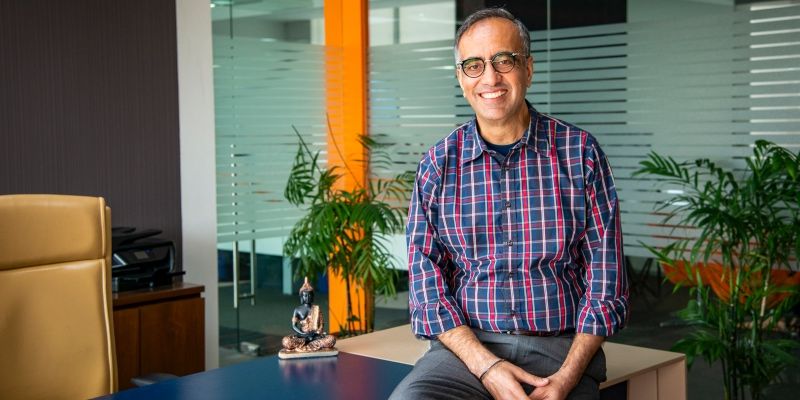From petrocards to digital payments infrastructure: how Pine Labs stayed ahead of the curve by doing this one thing
One of India’s oldest fintech companies, Pine Labs started out as a simple card-based payment and loyalty programme in 1998. Its founders left a few years later. The company, however, didn’t just survive, but stayed a step ahead of its competitors. Here's how.
Pine Labs is not a brand that resides in your wallet the way Visa, MasterCard or American Express do, but if you’ve ever swiped your card to pay for something, chances are, you’ve probably done so on a point-of-sale (PoS) machine from Pine Labs.
That little PoS machine does more than just process your payment. Connected to the cloud, it is now a gateway to data that merchants – from small businesses to large department stores – want to understand to keep their customers, and have them come back for more.
Given that it is over 20 years old, many might say Pine Labs is not really a startup. Nevertheless, Executive Chairman and Former CEO Lokvir Kapoor proudly says it still has the DNA of a startup because of the innovation and the agility it has always demonstrated.
And that is just part of Pine Labs’ claim to fame. In its two-decade journey, the company achieved a unique distinction in Indian fintech – in FY2017, it became a profitable ‘unicorn’ (a company valued at over $1 billion), registering a net profit of Rs 3.80 crore.
The distinction was, sadly, short-lived because the next year, it raised $250 million in funding and expanded operations in a big way. According to filings with the Registrar of Companies (RoC), it clocked a loss of Rs 2.51 crore in FY2018, mainly because employee benefit expenses climbed 85 percent year-on-year.
This year, says Vicky Bindra, who took over as CEO from Lokvir last year, the focus is once again on raising funds (from existing investor Temasek) to expand its global presence and build its cloud platform to include players like Zomato, Paytm, Swiggy, and others.
So, while a return to profitability may not be on the cards immediately, Pine Labs today is one of the biggest PoS player’s in the country. It claims to have a 10 percent share of the PoS market, with over 300,000 PoS in the country. The team claims to have 15 percent of the card volume flowing through their network.
It now is going all out to dominate the world of PoS systems.

A timeline of Pine Labs, starting form 1998
Image credit: Shafeeq
From petroleum to retail PoS
From late 1990s to 2004, Pine Labs was a smart card-based payment and loyalty solution for the petroleum sector. In 2004, founders Rajul Garg and Tarun Upadhaya left the company. This is typically the kind of change that many promising startups cannot survive. Not so at Pine Labs.
Lokvir, who was working with the founding team, took over as CEO and spent the next decade taking Pine Labs beyond petrocards and loyalty points, and into the world of digital payments infrastructure, making the company an early mover in the fintech space.
When he took over, Lokvir also realised that everything they provided to existing customers in the petroleum sector (financial offerings, smart card solutions), could be easily extended to other retailers. “At the time, banks offered a counter sales terminal to merchants, which carried out transactions over a phone line. There was a gap in terms of what the merchants and the market needed from a payments technology solution, and what the banks were able to offer,” he recalls.
Having heard their customers had to say, Pine Labs zeroed in on this gap, became a technology partner for several banks, and started providing merchants with its PoS devices. Banks, in turn, referred Pine Labs to merchants, getting the company a much-needed foot in the door with first-time users.
“We have partnered with banks and payment aggregators and ensured our PoS terminal could process all forms of digital payments,” says Sanjeev Kumar, Chief Technology Officer at Pine Labs.
The likes of Future Group and Shoppers’ Stop signed on as its earliest clients, validating their idea. Being one of the first entrants in the market, in a few years, PineLabs became India’s largest PoS player.

Vicky Bindra, CEO, Pine Labs
Boost from RBI and a move to the cloud
The next big boost for Pine Labs came in 2012-13, when the Reserve Bank of India directed banks to enhance security on debit cards, which resulted in the four-digit PIN that is still used to complete offline transactions. The enhanced security layer saw debit card usage in India shoot up, pushing up demand for Pine Labs’ PoS machines.
Media reports that analysed data from banks at the time suggest the number of debit card users went up from 150 million in 2008 to 400 million in 2013. But, by this time, Pine Labs also had competition in the form of mSwipe and Ezetap.
As debit cards became more popular, merchants too began taking a deeper interest in how the payments process worked and how it could be made better. “They wanted to understand the spends, payment patterns, and details of consumers. They wanted integrated security,” recalls Lokvir.

Lokvir Kapoor, Executive Chairman, Pine Labs
Around this time, ecommerce and online payments too began picking up, Vicky points out. Media reports show that by 2013-14, close to 30 percent of retail credit card transactions and 15 percent of debit card transactions were online. And online players were collecting and analysing that data to sell better. Vicky explains,
“The PoS machine for offline merchants now needed to do more than just accept payments. It needed to help collect and collate information, and give discounts if needed.”
So, the team decided to build a cloud-based payments platform for offline merchants. Soon enough, Pine Labs’ PoS System replaced the plain vanilla card and bank-centric PoS terminal. This was a cloud-based platform that could process payments across debit, credit, gift, loyalty, and later United Payments Interface (UPI) and mobile wallets as well.
“When chip technology came in, by 2013-14, we had to get the machines, but then they had limitations of storage and memory was low. That’s when we moved towards cloud technology,” explains Sanjeev.
This ensured every transaction and billing detail entered by a cashier, along with the sales and transaction behaviour, was automatically transferred to the cloud.

Sanjeev Kumar, CTO, Pine Labs
A new navigator for a new strategy
In late 2017, Pine Labs decided to look beyond India at international markets, and started building new services for different types of merchants and stakeholders in the financial services ecosystem. New plans called for a new approach. It was at this time that Lokvir and the team decided to bring in Vicky Bindra.
Vicky was no outsider. He had already been on the company’s board as a non-executive director since 2016 and knew the business well. He had also worked with global credit card majors MasterCard and Visa, as well as large financial firms like GE Capital and Citibank. On his part, Vicky was intrigued by Pine Labs’ continuous focus on technology. Says Vicky,
“We have always tried to stay a little ahead and keep talking to clients to get an idea of what they need on the ground. And that also is the best thing for working for an organisation like Pine Labs. There never is a dull moment, and you keep learning, and keep evolving.”
Pine Labs says it currently has over one lakh merchants as clients, and has deployed more than 3.3 lakh PoS terminals. The company also boasts of $16 billion in annualised payments value, and claims to have facilitated $1 billion worth of customer credit through debit and credit cards.
According to Vicky, the company now has three primary goals – to focus on building a strong cloud-platform, to penetrate deeper into international markets, and to get the company IPO-ready by 2020-21.
While the move to the cloud raises questions on data privacy and security, Vicky is quick to add that the company’s processes are in strict compliance with banking and regulatory norms.

Rakesh Sharma, Head of Petroleum, Prepaid & Gifting Business
Time to mine the data in today’s PoS systems
The launch of UPI in 2016, followed by demonetisation in 2017 helped the next phase of development for Pine Labs.
According to data from the National Payments Corporation of India (NPCI) and the RBI, India clocked nearly 236 million UPI transactions and 419 million card-based transactions between June 2017 and June 2018. Non-card digital transactions constituted 58.9 percent of total digital transactions, up from a mere 11.5 percent at the end of 2017.
While consumers took advantage of the convenience of digital payments, merchants wanted to know more about customer behaviour.
So Pine Labs developed the myPlutus app to help merchants. The app gives them real-time access to sales transaction data, payments related insights, and customer analytics. It even has cashier training videos.
Then there are new solutions like BusinessPlus that give merchants real-time marketing tools and automated customer engagement programmes to help them increase sales and drive repeat buying.
Pine Labs’ mobile platform Plutus Smart is a Pine Labs’ android-based smart transaction machine allows merchants to process an entire sales transaction using a single hand-held device. It contains an in-built catalog that allows detailed comparison of EMI offers for different banks and tenures, dedicated customer feedback mechanism and an in-built IMEI number/barcode scanner.
And just like in the past, continuing to work closely with its merchants is what helped Pine Labs understand what these customers really wanted. Says Vicky,
“They wanted something that would help increase revenue and reduce cost and complexity. This led us to look at bringing in working capital loans for merchants and EMI options for consumers.”
Also read: Pine Labs revenue soars 55 pc in FY18 as the company slumps into loss after reporting profits
A deeper relationship with merchants via lending
In 2017, Pine Labs began providing short-term (0-90 days) financing and weekend credit to merchants to help them meet working capital and inventory needs.
“For EMI and loans, we had to tie up with NBFCs and lending partners as we didn’t have licenses. Now, we have now applied for one as well. Brands and merchants don’t have access to offers from across banks and NBFCs. So, we tied up with brands to reach across their distribution channels and all banks, so that we can have a large base,” says Vicky.
Pine Labs is also partnering with leading NBFCs to provide retailers access to easy and collateral-free business loans. Merchants have the option to repay these loans by choosing a flexible amount from daily card sales on Pine Labs’ PoS terminal.
Vicky says Pine Labs is on track to originate over $1 billion worth of instant loans at PoS terminals this fiscal. Merchants can also process no-cost EMIs from banks and brands at the point of sale. Each of these are different products but get integrated into the Pine Labs platform.

Kush Mehra, Chief Business Officer, Pine Labs
Covering all bases, in India and abroad
Kush Mehra, Chief Business Officer, told YourStory that Pine Labs’ idea is to cover every single need of the merchant when it comes to financial solutions and payments. Adds Vicky,
“When we started closely looking into the merchant needs in India, we realised there were players looking for similar things, and that is when we looked closer at a few international markets.”
At 2017-end, Pine Labs launched its complete suite of services in Southeast Asian markets, and has a presence in Malaysia.
Next on the anvil is a new smart mobile platform that offers an easy-to-use, intuitive interface for merchants. “Merchants and their customers in offline stores can now have the same flexible and personalised check-out experience as they do in popular ecommerce websites,” says Vicky.
As for competition, he remarks, “All of our different business verticals have individual competition and competitors whom we respect and look closely at. But we have always built for value, and that focus has helped us to continue growing.”











